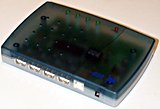
Skymaster USB hub
Review date: 15 April 1999. Last modified 03-Dec-2011.
I've always been of the opinion that there's not nearly enough see-through plastic in computer hardware. I *like* the look of circuit boards and mouse encoder wheels and joystick button contacts. If you're going to pay for all those little twiddly bits, why hide them in a beige box?
For that reason, I'm glad the iMac came along. Suddenly translucent green and blue was the order of the day among a variety of PC accessory makers - especially makers of USB hardware, to match the iMac's USB-centred design philosophy. All of these manufacturers may have had heart attacks when Apple released four new "flavours" of iMac, but us PC users don't care; we still get various see-through peripherals to play with, because USB devices work on any platform that has drivers for them.
One such iMac-ish device is the Skymaster USB hub, a common-or-garden four port bus-powered or self powered hub (like the Dynalink one I review here) but endowed both with nifty pseudo-Bondi Blue see-through styling and an attractive price - $115 (Australian dollars) retail. That's $50 less than the much less interesting looking Dynalink hub.

The provided USB cable's translucent as well. The
AC adaptor is still basic black.
Setting up
If you can't set up a USB hub, you should abandon this whole computing thing and take up turkey farming. While computer is on, plug one end of hub cable (also translucent greenish-blue) into PC. Plug other end into hub. If you're running a USB-aware OS (Windows 98 or Windows 95 Release B with the USB patch; Windows 98 is the better solution), sit back and watch the operating system find the new hardware automatically. If you're not running a USB-aware OS, go and get one.
Windows 98 regards the Skymaster hub as exactly the same as the more staid-looking Dynalink; when I plugged the Dynalink hub in Windows took a moment to set up a driver for it, but that same driver worked fine with the Skymaster hub and no extra installation step was needed. As with all proper USB gear, no rebooting is necessary. Users of proper operating systems will not consider this to be a particular selling point, but for Wintel PCs it's something of a novelty.
If you want to cascade other hubs from the Skymaster or run higher-power devices from it that don't have their own power supplies, you'll need to plug in the included chunky AC adaptor. Most users won't need it, though; leave it in the box unless and until you do.
Overall
Here's a USB hub that is both quite cheap and extremely cheerful. If you're a hopelessly beige sort of person, you may have to paint it, but most users should welcome a bit of see-through silliness, particularly when it doesn't cost any more.


